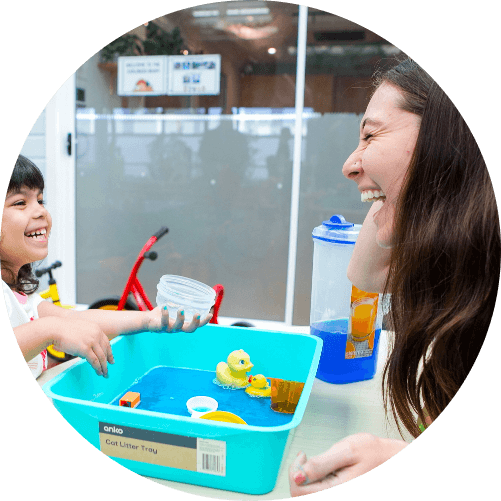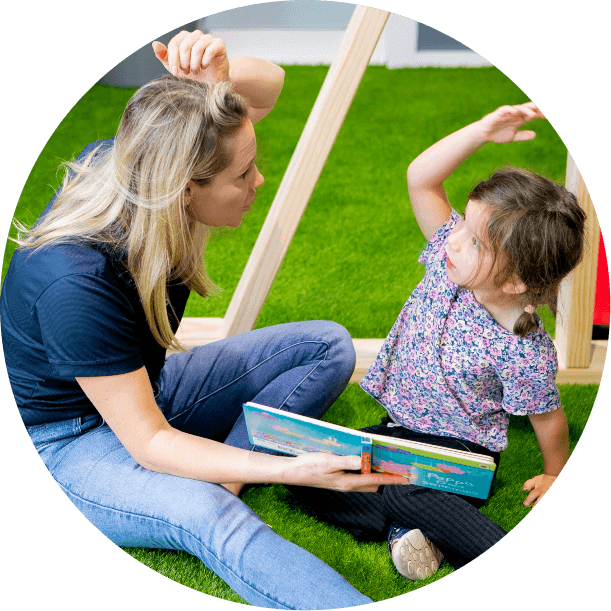


Speech Pathology and Occupational Therapy are known as traditional forms of early intervention. They are generally delivered in 30-60 min sessions weekly or fortnightly and goals are focused specifically on the areas of development related to that discipline.
While traditional early intervention is enough for some children, it has been proven in many research studies that the Early Start Denver Model produces more rapid progress for children with ASD or developmental delay, compared to attending traditional speech pathology and/or occupational therapy sessions weekly or fortnightly.

In most respects, the ESDM is unlike ABA. ESDM is the most naturalistic and least invasive way of teaching a child.
The key distinguishing features between these two therapy models are:

ABA is often focused on discrete trial training whereby your child must repeat a task as decided by the therapist in order to learn that skill.
The ESDM is play based and can be delivered in any setting eg. at home, in the car, the playground, the school room and the therapy room. The ESDM is your child having fun during therapy, making choices and receiving high quality natural teaching interactions to stimulate your child’s desire to learn new skills.

Applies theory of learning and behaviour to children with Autism.
Applies theory of learning and behaviour to children with Autism and considers well-being and child needs.
Structure and task oriented
Micro structures within activities based on child interests and choice. Learning opportunities in every interaction.

ABA therapists are typically trained to offer some kind of material object as a reward, such as food, stickers, or a favourite toy. This approach is developing extrinsic motivation for your child to follow instructions. The rewards become the extrinsic object and the experience of having that object, which can lose its value over time.
We know that children who are intrinsically motivated will do better in the long term and the therapy will have longer lasting impact.
The ESDM does not use material objects as rewards. The behaviours and skills we want to see more of are reinforced through smiles, giggles, and positive verbal and gestural reinforcement. This is called intrinsic motivation whereby your child wants to do the skill more because they want more reinforcement because it makes them feel good inside. It fulfils a sense of autonomy, competence and a relationship with others, which is known to create positive well-being.


Generally maintains a neutral affect until positive behaviour is demonstrated.
Always employs a positive affect, emphasising warm tone of voice, facial expressions, and body language to build relationships and attachment.

Uses external and tokenistic rewawrds to reinforce correct behaviour: stickers, lollies, favourite toy
Uses intrinsic rewards to reinforce correct behaviour: smiles & positive affect
Tends to ignore unwanted behaviour.
Focuses on understanding, responding to, and helping to manage children’s emotions and behaviours through emotion coaching and sensitivity.

Utilises a ‘most to least’ prompting strategy.
Least to most prompting


Uses tangible rewards (e.g., stickers, food) as consequences for correct behaviours.
Focuses on social rewards like praise, positive reinforcement, and giving children choices to encourage intrinsic motivation and adaptability in various contexts.
Primarily adult-led sessions.
Child-led sessions, allowing children to make choices and follow their interests to boost motivation and enjoyment.


Generally maintains a neutral affect until positive behaviour is demonstrated.
Always employs a positive affect, emphasising warm tone of voice, facial expressions, and body language to build relationships and attachment.
Tends to ignore unwanted behaviour.
Focuses on understanding, responding to, and helping to manage children’s emotions and behaviours through emotion coaching and sensitivity.


Utilises a ‘most to least’ prompting strategy.
Employs a ‘least to most’ prompting strategy, allowing children more opportunities to respond independently before increasing assistance.
ESDM is built on the belief that engagement in natural and interactive settings leads to better motivation, engagement, spontaneous learning, and generalisation of skills. It incorporates elements of Pivotal Response Training and builds on the foundational principles of the Denver Model. The ESDM approach is supported by contemporary research highlighting the importance of play and learning within the context of relationships.
While Speech Therapy, Occupational Therapy, ABA and ESDM have their place in early intervention and can be effective in different contexts, the choice between them depends on the unique needs and responses of each child. The ESDM’s emphasis on social rewards, emotional engagement, child-led learning, and understanding of behaviour through empathy offers a distinctive approach, particularly in encouraging independence, confidence, and positive relationships.

We invite you to learn more about how the Child Development Institute can make a significant difference in your family’s life. Whether it’s about taking the first steps or continuing the journey, we’re here to support you every step.
Contact us today to schedule a consultation and begin a new chapter in your child’s developmental story.

To the parents navigating the world of ASD, take the next step with confidence. At the Child Development Institute, we’re not just a centre; we’re a community where your child’s growth and happiness are our foremost priorities.
Visit Our Centres
173 Warringah Rd,
Beacon Hill, NSW, 2100
(02) 9008 1106
6/185 Briens Road
Northmead, NSW 2152
(02) 9037 1163
General Enquiries
Copyright © 2024 Child Development Institute. All Rights Reserved
Web Design by The Site Coach